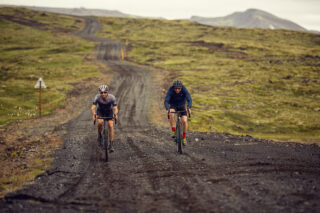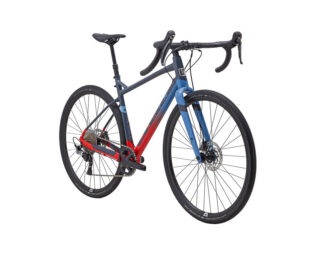What's the Best Gravel Bike For You to go Beyond Road?

What The Heck Is Gravel Anyway?
“Gravel” is a relatively new name for a type of bike that’s been around longer than any of us.
Back in the early days of cycling, the divisions between on-road and off-road bikes were blurry, sometimes nonexistent. The first person to ride a bike round the world finished in 1886. Asphalt wasn’t invented until 1902. Just think about that for a second!
Even after manufacturers started designing bicycles for surfaced roads, riders kept pushing their limits. Road racers would train by racing off-road in the winter, and the sport of cyclo-cross was born. And adventurous cycle tourers would use their bikes as a means of crossing wild, uncharted terrain and gravel was born.

Modern gravel bikes have evolved from every corner of cycling.
Road bike-style drop bars and 700c wheels give them speed on the tarmac, but they can also accept racks and mudguards for commuting or touring. Gravel bikes tend to have fatter tires than dedicated cyclo-cross bikes, because they’re meant to be ridden all year round, rather than just carving through muddy winter racecourses. And to mix things up even more, innovations from the mountain bike world like dropper posts and tubeless tires are starting to show up in the land of gravel too.
Gravel bikes might look like road bikes, but they ride very differently. Most road bikes are limited to narrow tires due to lack of frame clearance, but on a gravel bike, there’s more cushioning between you and the road, giving a more comfortable ride. Gravel bikes also have lower gears to make the hills less painful, even with camping, commuting or bike packing gear on board. They’re also designed for a relaxed riding position, but are generally a bit lighter and more lively than old skool touring bikes.
Many modern gravel bikes come with plenty of mounts to attach luggage and bike packing equipment, disk brakes are standard fare, dropper posts have become more and more common.
Many people ask “can I put gravel tires on a road bike?” and the answer is usually no, but that depends on your frame.

So why “gravel”? It’s a term that comes from the US, where it’s used to describe the miles of unsurfaced dirt roads that sweep across its mountains, plains and forests. Gravel bikes aren’t just good on gravel roads though: they’re fun to ride on anything from dirt tracks to rought roads to tamer mountain bike trails.
It’s for that reason we’ve given our bikes the Marin ‘Beyond Road’ title because that’s exactly what they do, they’ll take you down the road and beyond the asphalt to whatever comes next.
And that’s the real joy of gravel bikes: they’re not as capable as a mountain bike on the off-road stuff, or as fast as a road bike on the road, but when you’re riding one, you can mix and match terrains without having to worry about whether you’re on the right tool for the job.
Because it’s easy to cover some serious mileage on a gravel bike, they’re a good training aid if you’re looking to boost your fitness, a great way of exploring the riding your local area has to offer, and they can also make short work of your daily commute, whilst letting you throw in some traffic-free route options.
There are also lots of dedicated gravel biking events and multi-day rides around the globe. Some are seriously tough challenges, but many go for a fun, inclusive vibe that’s very welcoming to beginners. We’d recommend the Grinduro series of gravel events as a great place to start.

The question of what to wear on a gravel bike is somewhat divided and - like any new trend in cycling - creates plenty of debate.
Roadies going beyond road tend to wear lycra, opting for the aero benefits and comfort of lycra. Mountain bikers straying into gravel tend to wear baggie shorts and technical teeshirts, with mountain bike pedals and looser fit, more flatting gear.
In our experience, skinny-fit kit is best suited to long days in the saddle and rides where you maintain higher speeds for longer periods. Rides that lean a little more towards the ‘road’ end of gravel. Baggier, looser-fit kit is often better suited to more off-road, slower-paced rides. That is, rides that lean a little more towards the ‘mountain biking’ end of the gravel spectrum.
Either way, what you wear doesn’t really matter. Many people love the inclusivity of gravel and the fact that riders of all shapes and sizes, styles and fashions can rider together in whatever gear and on whatever bike they feel comfortable. Pick your gear based on what you have in your wardrobe and what you feel the happiest riding in.

Should I Get A Gravel Bike?
The answer to “should I get a gravel bike?” is of course yes!
If you like the sound of this and you're thinking of springing for a gravel or ‘Beyond Road’ bike, there are a few things to look out for.
We’ve already talked about wide tires but these make a big difference: going a bit wider than standard 28mm road or 32mm cyclocross tires really helps comfort and control when things get rough. Wider bars with a bit of flare can put your hands in a more natural position, which is great on longer rides or broken-up surfaces. Bolt-thru axles are super secure over the rough stuff and make for stiffer steering. Mounts matter too: the ability to attach front or rear racks, mudguards and specialist accessories like top tube boxes and frame bags comes with virtually no weight penalty, but makes your bike much more versatile.
Disc brakes are a revelation if you haven’t used them before: lots of controllable power and no more worn-out rims or brake blocks. Mechanical disc brakes are easy to maintain wherever you are in the world, although hydraulic discs are a good upgrade if you can find the budget for them. Most modern gravel frames use low-profile flat brake mounts, which are super neat and keep the weight low. Single ring drivetrains are taking over the gravel world too - they’re reliable, wide enough for hilly days out, and if you want to get really rad, they free up your left-hand lever so it can be used to activate a dropper post.
So while gravel riding might be as old as the bicycle itself, the new generation of gravel bikes have lots of tricks up their sleeves to make them fun, fast and hassle-free.

The Gravel All-Rounder
The Gestalt range of gravel bikes are Marin’s obvious starting point for the gravel-curious, with light but tough alloy frames, sure-stopping disc brakes and a wide choice of builds to suit your budget.
The range starts with the base model Gestalt, which uses dependable kit like a 2x8 FSA/Shimano drivetrain, Promax disc brakes and fast-rolling WTB Exposure tires to deliver a super solid commuter bike, but you could still tackle proper off road trails with a quick swap to knobbly treads.
The Gestalt 1 and 2 add a carbon fork for extra comfort and less weight, and have higher-end components.
The Gestalt X10 and X11 shift up to 1x drivetrains. The flagship X11 comes with Shimano’s new gravel-specific GRX shifters and brakes, Schwalbe’s benchmark G-One tires, and even has a Tranz-X dropper post for extra control on the descents - or popping wheelies, whatever floats your boat.
The Steel Swiss Army Knife
Here at Marin we’re big fans of steel frames. The ride quality and look of a well-made steel bike just has a certain something that other materials struggle to replicate.The Marin Nicasio series aren’t retro throwbacks though.
The base model is a great value workhorse, with Shimano shifters, a bombproof CroMo fork and clearance for up to 40mm tires. The Nicasio 2 upgrades to a full carbon fibre fork, Shimano hydraulic brakes and tubeless-ready WTB Riddler tires.
The Marin Nicasio range has a neat trick up its sleeve - all the models are also compatible with 650B wheels, which are slightly smaller, but allow you to run much bigger tires and take on some seriously rugged terrain. The Marin Nicasio+ comes as standard with WTB’s Horizon Road Plus tires, or you can pick up a second set of wheels and have two bikes in one.


The Head-Down Racer
The Marin Headlands is the newest addition to Marin’s gravel family: taking the proven design of the Gestalt as its starting point, but using carbon fiber to create a super lightweight frameset.
It’s not all about pure speed though: the bikes in the Marin Headlands range have great tyre clearance and are fully rack and fender compatible. They also have extra mounts for water bottles, cargo cages or a top tube bag, meaning you’ll be able to take everything you need for overnight trips without having to worry about luggage straps rubbing on your pride and joy.
The Headlands is available as a frame only, or two builds with Shimano GRX gears and brakes. All models are compatible with 700Cx45 or 650Bx50mm tires.
The Rugged Adventurer and Bike Packer
Ever wanted to leave the rat race behind and ride off towards the horizon in search of adventure?
The Marin Four Corners is aimed at the rider who wants to load up and head out, with a tough but comfortable CroMo frame and fork, bottle cage and rack mounts aplenty, a 3x9 Shimano drivetrain and Tektro’s dependable Spyre mechanical disc brakes.
Mile-munchers will appreciate extra details like the extra gel pads under the bar tape, and the puncture protection in the chunky WTB Resolute tires, but it’ll also work just as well as a commuter, or a ticket to explore your local trail network.


The Flat Bar Wild Card
So far we’ve only talked about gravel bikes with drop bars, but we know that some people just don’t get on with them.
The Marin DSX range of bikes are all built around flat handlebars, but they’re as far away from boring hybrids as you can get. The models have light alloy frames, full carbon forks, 700x45c WTB tires, hydraulic disc brakes, dropper seatpost compatibility and super clean lines thanks to internal cabling. The geometry of the DSX range has been tweaked too, so mountain bikers will feel at home immediately.
The DSX FS adds a front suspension fork to the mix. Is it a gravel bike on steroids? A mountain bike on a diet? Who cares, as long as it’s fun, right?
You Might Also Be Interested In
Marin's 5 Top Tips for Commuting By Bike
Thinking of switching from four wheels to two? We've prepared our top tips for commuting by bike.
Zobacz więcej"This is a mountain biker's gravel bike, 100%"
Marin County-based YouTuber Tim Williams spent a few months this winter with a DSX 2. Here's his review.
Zobacz więcej''There’s no denying that this little bike is a lot of fun.''
DSX 2 Earns an 8.5/10 Review at ADVNTR.cc
Zobacz więcej

